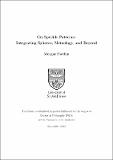On speckle patterns : integrating spheres, metrology, and beyond
View/
Date
12/06/2023Author
Grant ID
RPG-2017-197
EP/P030017/1
EP/R004854/1
Metadata
Show full item recordAbstract
Speckle patterns are grainy intensity patterns resulting from the random interference of light. They often arise from the interaction of light with systems that have a complex structure at the scale of the wavelength. As most ordinary objects have this property, speckle patterns are a somewhat universal phenomenon, although not easily observable under ordinary circumstances due to the lack of coherence of natural light. Since the invention of lasers however, the production of speckle patterns has become extremely simple, and a whole field of optics has emerged from it. Speckle patterns are an excellent tool for metrology. Where intuition says that precise control over all aspects of a setup is required, it is found that introducing some disorder can lead to very powerful techniques, with considerably simpler implementations. In this thesis, we explore new theoretical aspects of speckle patterns and develop new metrology techniques. We pay particular attention to the case of speckle patterns produced by an integrating sphere, which has only recently been used in this field of study. In this geometry, we develop a general model that predicts the amount of change in the resulting speckle, as a result of an arbitrary transformation. This model gives explicit results for various physical effects that can be solved from first principles, such as a variation in wavelength, refractive index, temperature, and position. We use this model in the context of metrology, and improve the state of the art by several orders of magnitude in the case of refractive index variations and displacement. We also explore the relationship between speckle and polarisation, and describe new mathematical techniques for the design of speckle patterns with custom properties (i.e. with maximal and minimal sensitivity to a measurand of interest) using light shaping.
Type
Thesis, PhD Doctor of Philosophy
Rights
Embargo Date: 2025-03-06
Embargo Reason: Thesis restricted in part in accordance with University regulations. Chapter 8 restricted until 6th March 2025
Collections
Items in the St Andrews Research Repository are protected by copyright, with all rights reserved, unless otherwise indicated.

